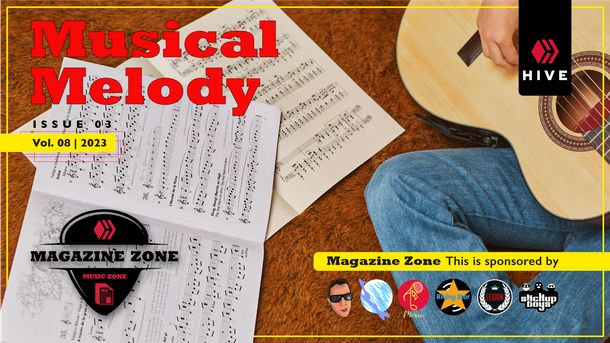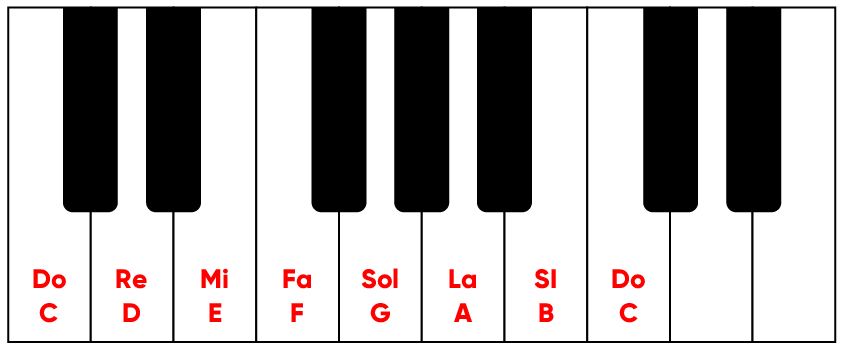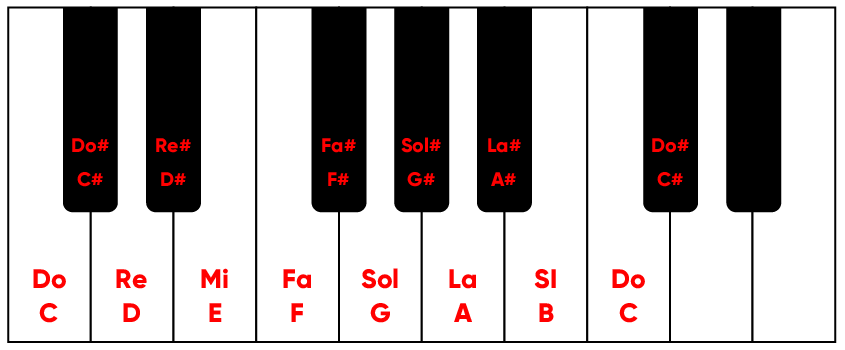
Source | Fuente
Musical Melody
Melodía Musical
In the volume Elements of Music we said that we could construct melodies, that these are heard in a structured way and that they have rhythm, varied or constant, and timbre, either single or several mixed. At this point things get a little complicated, a melody is not composed using random notes, doing it that way we will only get a lot of notes that will be unnecessary and will sound ugly. This gives us an idea that to build a melody we must take into account some considerations so that the sequence of notes used are pleasant to listen to. So, the ancient musicians, in view of this, invented scales.
En el volumen Elementos de la Música dijimos que podíamos construir melodías, que estas se escuchan de manera estructurada y, que poseen ritmo, variado o constante, y timbre, bien sea único o varios mezclados. En este punto las cosas se complican un poco, una melodía no se compone usando notas al azar, hacerlo de esa manera solo conseguiremos una gran cantidad de notas que resultaran innecesarias y sonarán feas. Esto nos da una idea de que para construir una melodía debemos tomar en cuenta algunas consideraciones para que la secuencia de notas que se usen resulten agradables al escucharlas. De modo que, los músicos antiguos, en vista de esto, inventaron las escalas.
According to our musical language, the western tonal, a scale is an ordered series of notes that go from one note to another note much higher (or lower) but that sounds the same, located at eight degrees. Scientific knowledge tells us that the eighth degree sounds similar because it has the exact double of vibrations per second, it is what they called Frequency. What is meant is that, if we start from the note C, we will have a C in the octave above, and this will have twice the vibrations of the starting C. All the notes that are within the C will have twice the vibrations of the starting C. All the notes that are within the C will sound the same, located at eight degrees. All the notes that are within the C and the C of the upper octave will form a scale.
Según nuestro lenguaje musical, el occidental tonal, una escala es una serie ordenada de notas que van desde una nota hasta otra bastante más alta (o baja) pero que suena igual, ubicada a ocho grados. El saber científico nos dice que el octavo grado suena similar porque se tiene el doble exacto de las vibraciones por segundo, es lo que ellos llamaron Frecuencia. Lo que se quiere decir es que, si partimos de la nota Do, tendremos un Do en la octava de arriba, y esta tendrá el doble de las vibraciones del Do de partida. Todas las notas que estén dentro del Do y el Do de la octava superior formarán una escala.

[Image created in Adobe Illustrator | Imagen creada en Adobe Illustrator]
To make this explanation a little more visual, we can observe this virtual image of a piano, we can notice that between C and C there are black and white keys. Counting the distance for each key, the distance between the C's is twelve intervals, which are called semitones, where two semitones give us as a result a tone. Between each note there is a difference of one semitone, it is written with the sign #, and it means that the pitch rises half a tone. Playing the succession of notes from C to the upper C, we will have the following:
Para hacer un poco más visual esta explicación, podemos observar esta imagen virtual de un piano, podemos notar que entre Do y Do hay teclas blancas y negras. Contando la distancia por cada tecla, la distancia entre los Do es de doce intervalos, que se llaman semitonos, donde dos semitonos nos dan como resultado un tono. Entre cada nota existe una diferencia de un semitono, se escribe con el signo #, y significa que sube la altura a medio tono. Tocando la sucesión de notas de Do al Do superior, tendremos lo siguiente:
Do, Do#, Re, Re#, Mi, Fa, Fa#, Sol, Sol#, La, La#, Si, Do superior.
C, C#, D, D#, E, F, F#, G, G#, A, A#, B, high C.




This sequence of notes is characterized by having all the possible notes, it is called Chromatic Scale. It is not the C scale. Most of the melodies we listen to, in general, are not built with the chromatic scale, but use scales that start from the chromatic scale in a specific way, we will understand this as the Tone Scale.
Esta secuencia de notas se caracteriza por tener todas las notas posibles, es llamada Escala Cromática. No es la escala de Do. La mayoría de las melodías que escuchamos, por lo general, no son construidas con la escala cromática, sino que usan escalas que parten de la escala cromática en una forma específica, entenderemos esto como la Escala Tonal.

[Image created in Adobe Illustrator | Imagen creada en Adobe Illustrator]
Returning to the virtual piano, we notice that each white key is followed by a black key, that is to say, that each note is followed by its sharp, as described in previous paragraphs. Observing in detail we can see that there is no note E#, nor the note B#. The explanation is simple, the distance between E and F and between B and C is only half a tone or semitone, however, for the rest the distance is of a complete tone, C and D, D and E, F and G, G and A, and A and B. This is the reason why the piano has its particular arrangement with its black and white keys.
Volviendo al piano virtual, notamos que a cada tecla blanca le sigue una tecla negra, es decir, que a cada nota le sigue su sostenido, como lo describimos en párrafos anteriores. Observando a detalle nos podemos dar cuenta que no existe la nota Mi#, tampoco la nota Si#. La explicación es simple, la distancia entre Mi y Fa y entre Si y Do es solamente medio tono o semitono, sin embargo, para el resto la distancia es de un tono completo, Do y Re, Re y Mi, Fa y Sol, Sol y La, y La y Si. Esta es la razón por la que el piano tiene su particular arreglo con sus teclas blancas y negras.
Then, by playing the notes in particular modes we will have specific successions, with exclusive characteristics. This provides us with a large number of scales with which we can work our compositions, which convey different feelings, and which possess unique colors, textures and nuances. These scales will be differentiated in their type by the order in the distance of their notes, specific successions of tones and semitones, giving rise to Major Scales and Minor Scales, among others. We will stop at this point before things get too complicated, because the different scales have their complexity and uniqueness.
Entonces, al tocar las notas en modos particulares tendremos sucesiones específicas, con características exclusivas. Esto nos proporciona una gran cantidad de escalas con las que podemos trabajar nuestras composiciones, que trasmiten diferentes sentimientos, y que poseen colores, texturas y matices singulares. Estas escalas se diferenciarán en su tipo por el orden en la distancia de sus notas, sucesiones específicas de tonos y semitonos, dando lugar a Escalas Mayores y a Escalas Menores, entre otras. Nos detendremos en este punto antes de que las cosas se compliquen demasiado, porque las distintas escalas tienen su complejidad y singularidad.




A word from Jesús
Unas palabras de Jesús
 Por: Jesús Tortolero | @yisusth
Por: Jesús Tortolero | @yisusth Melody is a poetic discourse that possesses the essential qualities of sound, such as pitch, duration, intensity and timbre. It is accompanied by other elements such as rhythm and harmony. Melody can be written in verse or prose. When written in verse there are repetitive patterns, with a specific number of measures, beats, rests and accents. In the case of prose, it does not have that rigid structure, it is something natural and does not necessarily have to rhyme. In the case of musical improvisation, there are no walls separating these literary languages. The melody is made up of musical phrases or motifs. Within a musical discourse there can be questions and answers, you can also pose a hypothesis, give arguments and even not reach any conclusion. There are no limits to create a melodic concept.
La melodía es un discurso poético que posee las cualidades esenciales del sonido, como la altura, la duración, la intensidad y el timbre. Este va acompañado de otros elementos como el ritmo y la armonía. La melodía puede ser escrita en verso o prosa. Cuando se escribe en verso hay patrones repetitivos, con una cantidad específica de compases, tiempos, silencios y acentuaciones. En el caso de la prosa, esta no tiene esa estructura rígida, es algo natural y que no necesariamente tiene que rimar. En el caso de la improvisación musical, no hay muros que separen estos lenguajes literarios. La melodía está conformada por frases o motivos musicales. Dentro de un discurso musical puede haber preguntas y respuestas, también se puede plantear una hipótesis, dar argumentos e incluso no llegar a ninguna conclusión. No existen límites para crear un concepto melódico.

🔸



It is not easy to create a purely original melody, there is always an influence of an artist, a musical scale, or a cultural context. Surely it happens to you that you hear a melody, and you say: This song is similar to this or another one. The original musical creation can be accomplished by joining different materials. The composer must be a musical architect and engineer when creating a melody. Many times we hear a melody, and it even connects us quickly with the composer. Each composer is a different world, and has a characteristic stamp. When creating a melody we must beware of copies and plagiarism. We must verify that we are complying with all the parameters to acquire licenses and not violate copyright. Nowadays it can be discussed how ethical it would be to create melodies using Artificial Intelligence. This can be a very effective tool to verify copyright.
No es fácil crear una melodía netamente original, siempre hay una influencia de un artista, de una escala musical, o de un contexto cultural. Seguramente les pase que escuchan una melodía, y dicen: Esta canción se parece a esta u otra. La creación musical original puede llevarse a cabo al unir diferentes materiales. El compositor debe ser un arquitecto e ingeniero musical al momento de crear una melodía. Muchas veces escuchamos una melodía, e incluso nos conecta rápidamente con el compositor. Cada compositor es un mundo diferente, y tiene un sello característico. A la hora de crear una melodía debemos cuidarnos de las copias, y los plagios. Se debe verificar que se estén cumpliendo todos los parámetros para adquirir licencias y no incumplir con los derechos de autor. Hoy día se puede discutir cuán ético sería crear melodías utilizando Inteligencia Artificial. Esta puede ser una herramienta muy eficaz para verificar el Copyright.
Anywhere you can create a melody, in the shower, walking to school, or to work. It can also be in a sophisticated way in a recording studio or using a musical instrument. No matter the order, the melody may come first before the lyrics and rhythm or vice versa. It can also happen that a harmonic pattern comes to your mind and then everything flows into a melody. Some ideas come from improvising, and experimenting with sounds, and scales. It is important to take notes so as not to forget a melody. As soon as you have an idea, it is good to take a sheet of paper and write it down. In case you have no knowledge of musical language, you can record and store voice notes. Maybe the chorus of a song comes to your mind, and then the bridges and verses come to your mind. Then we can resort to the stored information. In the heart there is always a melody written, we just have to interpret it.
En cualquier lugar se puede crear una melodía, en la ducha, caminando a la escuela, o al trabajo. También puede ser de manera sofisticada en un estudio de grabación o usando un instrumento musical. No importa el orden, puede que la melodía venga primero que la letra y el ritmo o viceversa. También puede ocurrir que venga a tu mente un patrón armónico y luego todo fluya hasta obtener una melodía. Algunas ideas surgen al improvisar, y experimentar con sonidos, y escalas. Es importante tomar notas para no olvidar una melodía. Apenas tengamos una idea, es bueno tomar una hoja pautada y escribir. En caso de que no tengas conocimientos de lenguaje musical, puedes grabar y almacenar notas de voz. Quizás llegue a tu mente el coro de una canción, y luego lleguen a tu mente los puentes y las estrofas. Entonces podemos recurrir a la información almacenada. En el corazón siempre hay una melodía escrita, solo debemos interpretarla.

🔸


We invite you! | Te invitamos

Music Zone
©2023 - Todos los derechos reservados
©2023 - Todos los derechos reservados







~~~ embed:1646291543848894468 twitter metadata:MTA1MDg3MzIwMjA3ODA4NTEyMXx8aHR0cHM6Ly90d2l0dGVyLmNvbS8xMDUwODczMjAyMDc4MDg1MTIxL3N0YXR1cy8xNjQ2MjkxNTQzODQ4ODk0NDY4fA== ~~~
~~~ embed:1646604173859868689 twitter metadata:MTYxNDc1NDA2OTIyNjA2MTgyNHx8aHR0cHM6Ly90d2l0dGVyLmNvbS8xNjE0NzU0MDY5MjI2MDYxODI0L3N0YXR1cy8xNjQ2NjA0MTczODU5ODY4Njg5fA== ~~~
The rewards earned on this comment will go directly to the people( @augusto-cordova, @edwardstobia, @hectgranate, @yisusth ) sharing the post on Twitter as long as they are registered with @poshtoken. Sign up at https://hiveposh.com.
Muy buena la clase sobre música (melodía) incluso para los que no somos músicos pero nos encanta oirla
Agradecido estimado lector. Nuestro objetivo es que las personas puedan adquirir conocimientos integrales para la vida y en el caso de los músicos reforzar algunas conocimientos y habilidades que serán de ayuda en su crecimiento profesional.
Congratulations @musiczone! You have completed the following achievement on the Hive blockchain And have been rewarded with New badge(s)
Your next target is to reach 40 posts.
You can view your badges on your board and compare yourself to others in the Ranking
If you no longer want to receive notifications, reply to this comment with the word
STOPTo support your work, I also upvoted your post!
Check out our last posts:
Support the HiveBuzz project. Vote for our proposal!